Hiroshima Peace Memorial
The Hiroshima Peace Memorial (広島平和記念碑, Hiroshima Heiwa Kinenhi), originally the Hiroshima Prefectural Industrial Promotion Hall, and now commonly called the Genbaku Dome, Atomic Bomb Dome or A-Bomb Dome (原爆ドーム, Genbaku Dōmu), is part of the Hiroshima Peace Memorial Park in Hiroshima, Japan and was designated a UNESCO World Heritage Site in 1996.[1] The ruin of the hall serves as a memorial to the over 140,000[2] people who were killed in the atomic bombing of Hiroshima on 6 August 1945.
| UNESCO World Heritage Site | |
|---|---|
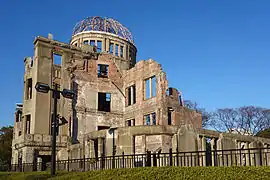 Ruin of Hiroshima Prefectural Industrial Promotion Hall | |
| Location | Hiroshima, Japan |
| Criteria | Cultural: vi |
| Reference | 775 |
| Inscription | 1996 (20th session) |
| Coordinates | 34°23′44″N 132°27′13″E |
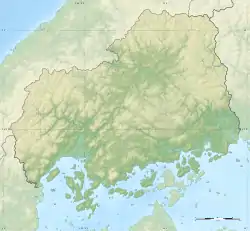 Location of the Peace Memorial. Architect Jan Letzel.  Hiroshima Peace Memorial (Japan) | |
History
The Product Exhibition Hall building was originally designed by the Czech architect Jan Letzel. The design included a distinctive dome at the highest part of the building. It was completed in April 1915 and was named the Hiroshima Prefectural Commercial Exhibition (HMI).[2] It was formally opened to the public in August that year. In 1921, the name was changed to the Hiroshima Prefectural Products Exhibition Hall, and again, in 1933, to the Hiroshima Prefectural Industrial Promotion Hall (広島県産業奨励館 Hiroshima-ken Sangyo Shourei-kan). The building was located in the large business district next to the Aioi Bridge and was primarily used for arts and educational exhibitions.[3]
Atomic bombing
At 8:15 a.m. on 6 August 1945, the first atomic bomb to be used in war was dropped by the United States Army Air Forces from the Enola Gay, a B-29 bomber. The force of the atomic bomb effectively obliterated the city of Hiroshima, Japan.[4]
Earlier, on 25 July, General Carl Spaatz, commander of the United States Strategic Air Forces in the Pacific, received orders to deliver a "special bomb" attack on selected cities in Japan.[5] The first target city chosen was Hiroshima, which had an important port on southern Honshu and was headquarters of the Japanese Second General Army with 40,000 military personnel in the city.[5] The bomb was assembled in secret and loaded on the Enola Gay. The bomb, code named "Little Boy", possessed a force equivalent to 15,000 tons of TNT. The plane dropped Little Boy over the city at 8:15:17 a.m. local time on 6 August 1945. Within 43 seconds of being dropped, it detonated over the city, missing its target by 240 m (790 ft). Intended for the Aioi Bridge, the bomb instead exploded directly over the Shima Hospital, which was very near to the Genbaku Dome. Because the explosion was almost directly overhead, the building was able to retain its shape.[6] The building's vertical columns were able to resist the nearly vertical downward force of the blast, and parts of the concrete and brick outer walls remained intact. The center of the blast occurred 150 m (490 ft) horizontally and 600 m (2,000 ft) vertically from the Dome. Everyone inside the building was killed instantly.[7][8] The building's durability can also be attributed to its earthquake-resistant design; it has held up to earthquakes before and since the bombing.
Preservation
Due to its stone and steel construction, the building was one of the few structures left standing near the bomb’s hypocenter.[1] Soon commonly called the Genbaku ("A-Bomb") Dome, due to the exposed metal dome framework at its apex, the structure was scheduled to be demolished with the rest of the ruins, but the majority of the building was intact, delaying the demolition plans. The Dome became a subject of controversy, with some locals wanting it torn down, while others wanted to preserve it as a memorial of the bombing and a symbol of peace.[9] Ultimately, when the reconstruction of Hiroshima began, the skeletal remains of the building were preserved.[1]
From 1950 through 1964, the Hiroshima Peace Memorial Park was established around the Dome. The Hiroshima City Council adopted a resolution in 1966 on the permanent preservation of the Genbaku Dome, officially named the Hiroshima Peace Memorial (Genbaku Dome). The Dome continues to be the park’s primary landmark.[1]
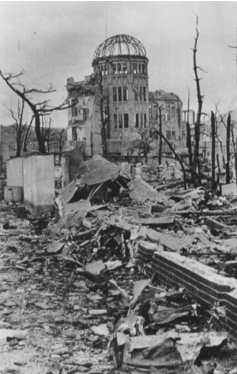
Weathering and deterioration of the Genbaku Dome continued in the post-war period. The Hiroshima City Council declared in 1966 that it intended to indefinitely preserve the structure, now termed "Genbaku Dome". The first popularly elected mayor of Hiroshima, Shinzo Hamai (1905–1968) sought funds for the preservation effort domestically and internationally. During one trip to Tokyo, Hamai resorted to collecting funds directly on the streets of the capital. Preservation work on the Genbaku Dome was completed in 1967.[2][11] The Genbaku Dome has undergone two minor preservation projects to stabilize the ruin, notably between October 1989 and March 1990.[2]
The Genbaku Dome stands almost exactly as it did after the bombing on 6 August 1945. Changes to the ruins, meant to ensure the stability of the structure, have been minimal.[1]
UNESCO World Heritage Site
In December 1996, the Genbaku Dome was registered on the UNESCO World Heritage List based on the Convention for the Protection of the World Cultural and Natural Heritage.[2] Its inclusion into the UNESCO list was based on its survival from a destructive force (atomic bomb), the first use of nuclear weapons on a human population, and its representation as a symbol of peace.[1]
Delegates to the World Heritage Committee from China and the United States had reservations regarding the confirmation of the memorial as a World Heritage Site. China cited the possibility that the monument could be used to downplay the fact that the victim countries of Japan's aggression suffered the greatest losses of life during the war, and the United States stated that having a memorial to a war site would omit the necessary historical context. The United States dissociated itself from the decision.[12]
Gallery
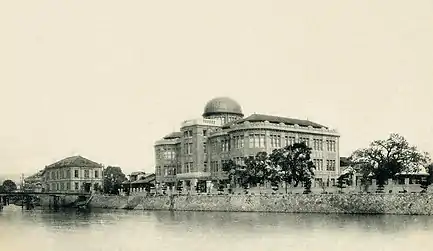 Products Exhibition Hall in its original condition (c. 1921–1933)
Products Exhibition Hall in its original condition (c. 1921–1933)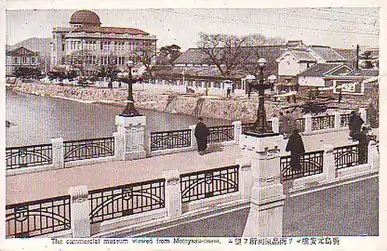 Hall, taken from Motoyasu Bridge (c. 1921–1933)
Hall, taken from Motoyasu Bridge (c. 1921–1933)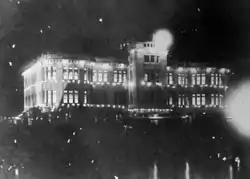 Nighttime photograph, 1921
Nighttime photograph, 1921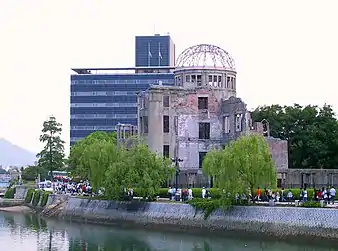 Citizens of the city pass by the Hiroshima Peace Memorial on their way to a memorial ceremony on 6 August 2004
Citizens of the city pass by the Hiroshima Peace Memorial on their way to a memorial ceremony on 6 August 2004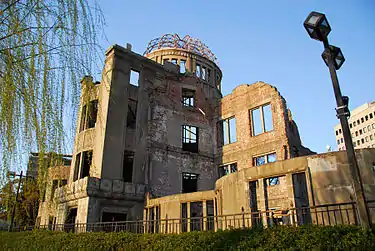 The Dome, photo taken from the southwest side
The Dome, photo taken from the southwest side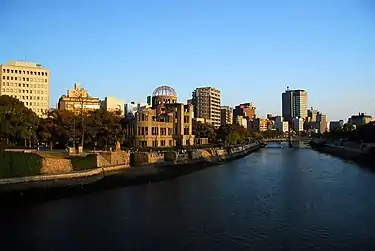 Distant view of the Dome; shot is taken from the Aioi Bridge
Distant view of the Dome; shot is taken from the Aioi Bridge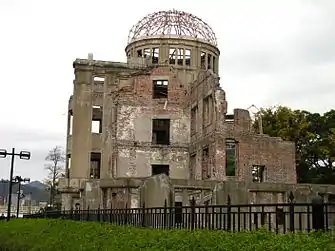 Side view of the Hiroshima Peace Memorial
Side view of the Hiroshima Peace Memorial Close up of the dome
Close up of the dome Dome with plaque
Dome with plaque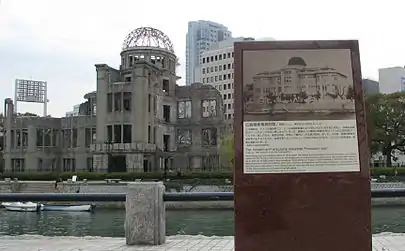 Peace Dome, then and now
Peace Dome, then and now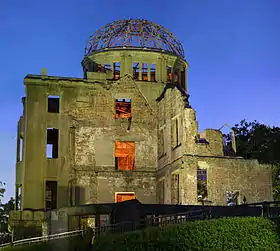 Genbaku Dome in 2007
Genbaku Dome in 2007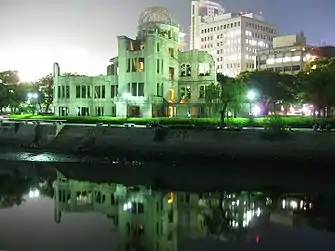 Genbaku Dome at night
Genbaku Dome at night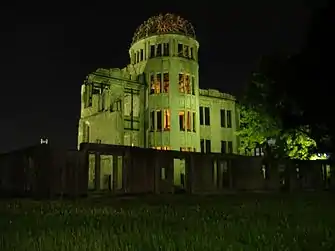 Genbaku Dome at night
Genbaku Dome at night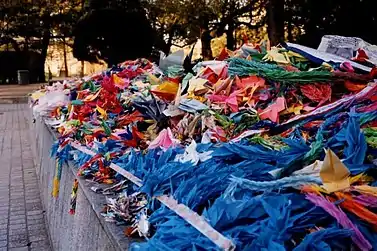 Origami cranes
Origami cranes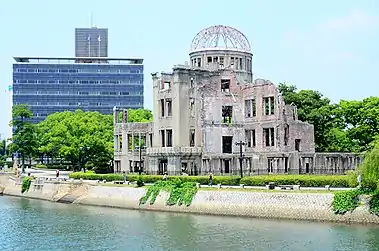 Hiroshima dome as seen from the memorial park
Hiroshima dome as seen from the memorial park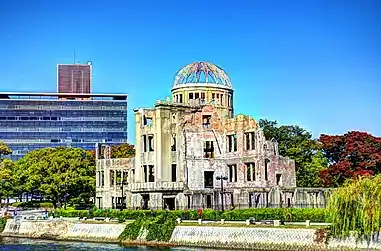 Genbaku Dome in October 2015 (HDR Image)
Genbaku Dome in October 2015 (HDR Image)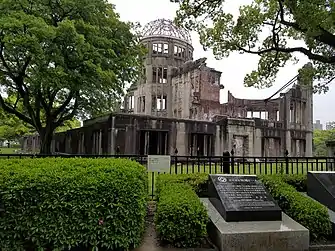 Overcast in the spring (May 2017)
Overcast in the spring (May 2017)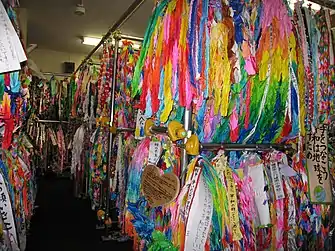 Origami cranes at Hiroshima Peace Memorial
Origami cranes at Hiroshima Peace Memorial.jpg.webp) Genbaku Dome in moonlight (November 2018)
Genbaku Dome in moonlight (November 2018)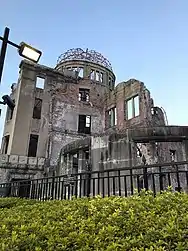 Atomic Bomb Dome pictured in 2020, 75 years after the bombing
Atomic Bomb Dome pictured in 2020, 75 years after the bombing
See also
References
- UNESCO. "Hiroshima Peace Memorial (Genbaku Dome)".
- "原爆ドーム" [A-Bomb Dome]. Nihon Daihyakka Zensho (Nipponika) (in Japanese). Tokyo: Shogakukan. 2012. OCLC 153301537. Archived from the original on 25 August 2007. Retrieved 18 September 2012.
- Logan, William (2008). Places of Pain and Shame: Dealing with 'Difficult Heritage'. Routledge.
- Schofield, John and Cocroft, Wayne (eds.) (2009). A Fearsome Heritage: Diverse Legacies of the Cold War. Left Coast Press.CS1 maint: multiple names: authors list (link) CS1 maint: extra text: authors list (link)
- Van Rhyn, Mark E. "Hiroshima, Bombing of". PBS. Retrieved 29 March 2013.
- Ide, Kanako (Winter 2007). "A Symbol of Peace and Peace Education: The Genbaku Dome in Hiroshima". Journal of Aesthetic Education. 4. 41 (4): 12–23. doi:10.1353/jae.2007.0036. S2CID 192640225. Retrieved 10 February 2014.
- Hiroshima Prefectural Industrial Promotion Hall Memorial Plaque
- Milam, Michael C. (July–August 2010). "Hiroshima and Nagasaki". Humanist. Buffalo, NY: American Humanist Association and the American Ethical Union. 70 (4): 32–35.
- Hiroshima Peace Museum
- "Let's look at the Special Exhibit: Hiroshima on October 5, 1945". Hiroshima Peace Memorial Museum. Retrieved 15 August 2010.
- "浜井信三" [Shinzo Hamai]. Nihon Jinmei Daijiten (in Japanese). Tokyo: Shogakukan. 2012. Archived from the original on 25 August 2007. Retrieved 23 October 2012.
- WH Committee: Report of the 20th Session, Merida 1996
External links
| Wikimedia Commons has media related to Hiroshima Peace Memorial (Genbaku Dome). |
- Official page
- Entry on UNESCO (United Nations Educational, Scientific and Cultural Organization) website
- U.S. Attending 2010 Hiroshima Memorial – video report by Democracy Now!
